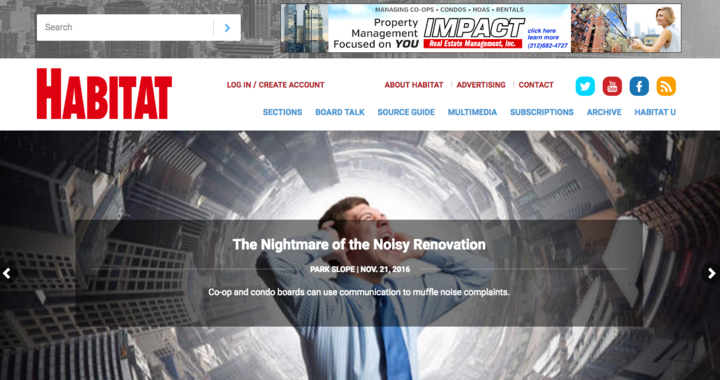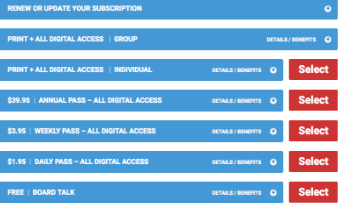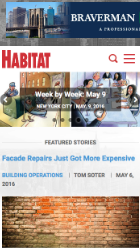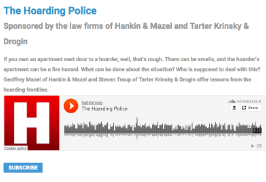Habitat Magazine builds a stronger foundation for content monetization
It was time that Habitat Magazine, a 35-year-old New York-based publication for co-op and condo boards, property managers, and community professionals, upgrade its own online home and enhance its capacity for revenue generation.
Its website, which dated back to 2006, had had incremental improvements over the years, but in order to get a better return on its rich content resources, including articles on board and building operations, condo buying, and eco-friendly ideas, it needed a new foundation to which it could add interactive features, sponsored video, responsive ads, and 15 years worth of archived articles.
After all, the publication is a must-read for members of the more than 8,000 residential co-ops, condos, and homeowner associations in New York, and its website had the potential to drive more revenue and a better experience for its readers.
Habitat had been relying on Mugo for site updates and maintenance since 2010. So last year, it asked Mugo to build a site that better leveraged its content archive, integrated print and digital subscription fulfillment systems, added videos, and made it easier and faster for editors to publish new content.
“Our website was very old fashioned and after following Mugo’s advice, we decided to redesign it,” said Habitat’s Editor-in-Chief, Carol Ott.
The Challenge -- Streamline Content Production and Distribution Systems
Habitat’s website was packed with great content, but its disparate systems needed to be streamlined. Separate systems for archived and current content caused unnecessary editorial inefficiencies. Editors were spending hours on content posting tasks that should have taken minutes. Feature articles on landing pages had to be managed manually, a time consuming process.
The separate content systems also required readers to create multiple accounts for print and digital subscriptions, as well as for access to its Board Talk forum, a bulletin board style community that enables readers to post questions and share information about co-op and condo issues.
Further, its ads were also managed in separate systems, which made ad sales across sections and devices difficult. Because its mobile site was on a separate platform, any change to an ad in the main site had to be duplicated on the mobile site (and often became an afterthought or an oversight entirely).
Finally and critically, Habitat wanted to experiment with new revenue generation streams, such as sponsored video, and needed the ability to host and feature video content throughout the site.
The Solution -- Integrated and Interactive Content = More Opportunities for Revenue Generation
Mugo set out to integrate all aspects of the site under one common CMS. Streamlined systems meant less work for staff managing content in different locations and formats, so they could focus more on audience engagement and revenue generation.
The redevelopment focused on the following areas:
Content migration
Mugo migrated Habitat’s article archive into an upgraded version of eZ Publish, making it easier for editors to work with and for paying subscribers to access. Print subscribers now receive unlimited access to the archive while online subscribers can choose from daily, weekly, or yearly access options.
With more content to showcase, the site now has more opportunities to increase traffic and revenue. The integrated system also makes it easier for Habitat to convert its free Board Talk account holders into paying digital and print subscribers.
Self-managed subscriptions and print fulfillment integration
Subscribing to the magazine is a more seamless process now. Subscribers need only create one account, through which they can self-manage their purchase and renewals online through Habitat’s print fulfillment company. User credentials are verified in eZ Publish and the user is placed in the appropriate subscriber tier, granting them access to specific content immediately.
All users are stored in a single database, making it easier for editors to get an accurate picture of the magazine’s subscribers. And for non-subscribers, who can access three free articles per month, eZ Publish automatically handles Habitat’s paywall, which involves metering content by user on a monthly basis.
Ad server and ad management solution
Ads are an important component of Habitat’s revenue streams. Mugo implemented an ad server with Google DoubleClick for Publishers (DFP) ad management solution. This allows for responsive ads for mobile, tablet, and desktop; section-specific ads; and fallback ads to auto fill empty ad spots. It also enables advertisers to purchase all ad spots on a given page or section, or all ad spots on a page load basis.
The system also auto-rotates ads in targeted spots, with weighting based on pageviews purchased, and facilitates reporting back to Habitat’s advertisers.
Responsive design
Mugo created a new responsive design for Habitat, to better serve users across devices. It also updated its videos from Flash to HTML5 in order to support mobile viewers.
Google AMP (Accelerated Mobile Pages)
Mugo implemented a Google AMP template for Habitat’s pages, which boosts load speed on mobile devices and has been shown to increase click-through rates. Google shows AMP results on mobile searches to ensure readers get results quickly and without using excess mobile data.
Analytics
Mugo integrated Google Analytics into Habitat’s new website, with custom event tracking for video plays and specific content downloads. Reports can filter results by content type, making it easy to analyze the success of each type of content.
New Opportunities for User Engagement and Revenue
Mugo created new areas for user engagement and revenue generation on Habitat’s website, including podcasts and videos, which can both be sponsored and featured on various pages throughout the site.
And because editors spend less time posting content, they can devote more of their time to creating new engagement points for readers.
Editorial Workflows
Mugo automated landing page management, drastically reducing maintenance time. Editors are also able to control sidebars and page footers to easily add and position various common elements to create different views.
“The redesign made our lives easier and more fun,” Ott said. “Publishing content is pretty effortless now: what used to take hours to be published now takes only a few minutes.”
“Mugo has done a pretty fabulous job in our website redesign,” she concluded. “It has been amazing to work with them. Our site is now modern, clean and easy to navigate. And I love the way it looks on the phone.”
The Result -- A Big Increase in Subscriptions and Revenue
Paired with a redesign, the new features on Habitat’s website have resulted in a dramatic increase in subscription sales and overall revenue, key metrics for a small magazine.
In the past year, Habitat has seen a 400% increase in subscription revenue, and its new sponsored video component now comprises 33% of its web revenue stream.
While its print revenue has remained fairly static, web revenue has seen a significant increase putting Habitat squarely in the black when it comes to web publishing.






